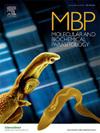Biophysical analysis of an oligomerization-attenuated variant of the Leishmania donovani dynamin-1-like protein
IF 1.5
4区 医学
Q4 BIOCHEMISTRY & MOLECULAR BIOLOGY
引用次数: 0
Abstract
Chemotherapy is a cornerstone in the battle against leishmaniasis, a neglected tropical disease caused by Leishmania parasites that affects millions worldwide. An alarming number of reports are describing treatment failure with currently available drugs, thereby explaining the dire need for the discovery of novel compounds, preferably with yet unexplored modes of action. In this respect L. donovani dynamin-1 like protein (LdoDLP1) is of interest as mutations in LdoDLP1 were recently shown to confer resistance to a new antileishmanial compound, suggesting it to be a potential drug target. Through a combination of biochemical, structural, and biophysical methods, we were able to show that wild-type LdoDLP1 has a strong inherent propensity to self-assemble into higher-order oligomers. Guided by structural modeling, a selection of nine point mutations (including resistance markers) were screened for oligomerization behavior to generate self-assembly impaired LdoDLP1 mutants that would occur in solution as dimers and/or tetramers. This led to the identification of a double mutant (G354D/R357S) that exhibits significantly altered and reduced, yet not completely abolished, oligomerization behavior. Further characterization of the LdoDLP1 G354D/R357S double mutant using small-angle X-ray scattering (SAXS) revealed that a fraction of the protein population occurs as a dimer in solution. Additionally, SAXS analysis experimentally confirmed that LdoDLP1, like other dynamin-like proteins, lacks the structurally defined pleckstrin homology (PH) domain of classical dynamins but instead possesses an intrinsically disordered B insert, grouping it among the dynamin-like proteins that play key roles in processes such as mitochondrial fission.
多诺瓦利什曼原虫动力蛋白-1样蛋白寡聚化减毒变体的生物物理分析。
化疗是对抗利什曼病的基石。利什曼病是一种被忽视的热带疾病,由利什曼原虫引起,影响全世界数百万人。数量惊人的报告描述了目前可用药物的治疗失败,从而解释了迫切需要发现新的化合物,最好是具有尚未探索的作用模式。在这方面,L. donovani动力蛋白-1样蛋白(LdoDLP1)引起了人们的兴趣,因为LdoDLP1的突变最近被证明对一种新的抗利什曼原虫化合物具有耐药性,这表明它是一种潜在的药物靶点。通过生物化学、结构和生物物理方法的结合,我们能够证明野生型LdoDLP1具有很强的自组装成高阶低聚物的内在倾向。在结构建模的指导下,筛选了9个点突变(包括抗性标记)的寡聚化行为,以产生自组装受损的LdoDLP1突变体,这些突变体将以二聚体和/或四聚体的形式在溶液中发生。这导致了双突变体(G354D/R357S)的鉴定,该突变体表现出明显改变和减少的寡聚化行为,但并未完全消除。利用小角x射线散射(SAXS)对LdoDLP1 G354D/R357S双突变体的进一步表征显示,一部分蛋白质群体在溶液中以二聚体的形式出现。此外,SAXS分析实验证实,与其他动力蛋白样蛋白一样,LdoDLP1缺乏经典动力蛋白结构定义的pleckstrin同源(PH)结构域,而是具有内在无序的B插入,将其归类为动力蛋白样蛋白,在线粒体裂变等过程中发挥关键作用。
本文章由计算机程序翻译,如有差异,请以英文原文为准。
求助全文
约1分钟内获得全文
求助全文
来源期刊
CiteScore
2.90
自引率
0.00%
发文量
51
审稿时长
63 days
期刊介绍:
The journal provides a medium for rapid publication of investigations of the molecular biology and biochemistry of parasitic protozoa and helminths and their interactions with both the definitive and intermediate host. The main subject areas covered are:
• the structure, biosynthesis, degradation, properties and function of DNA, RNA, proteins, lipids, carbohydrates and small molecular-weight substances
• intermediary metabolism and bioenergetics
• drug target characterization and the mode of action of antiparasitic drugs
• molecular and biochemical aspects of membrane structure and function
• host-parasite relationships that focus on the parasite, particularly as related to specific parasite molecules.
• analysis of genes and genome structure, function and expression
• analysis of variation in parasite populations relevant to genetic exchange, pathogenesis, drug and vaccine target characterization, and drug resistance.
• parasite protein trafficking, organelle biogenesis, and cellular structure especially with reference to the roles of specific molecules
• parasite programmed cell death, development, and cell division at the molecular level.

 求助内容:
求助内容: 应助结果提醒方式:
应助结果提醒方式:


